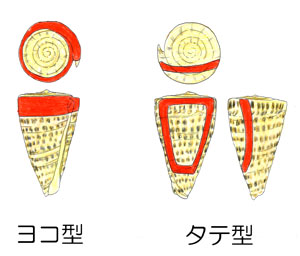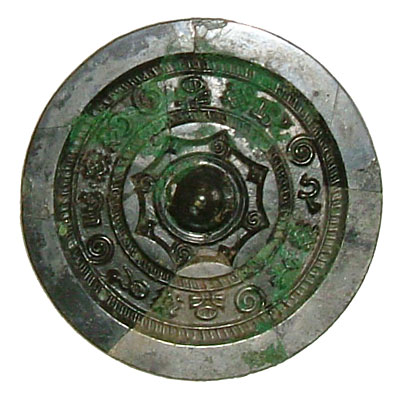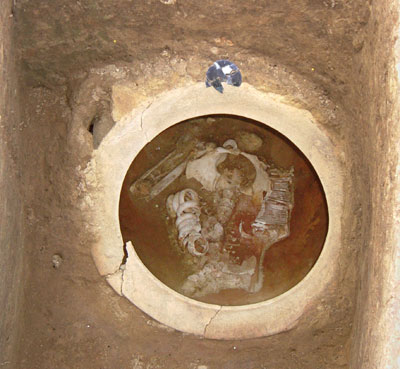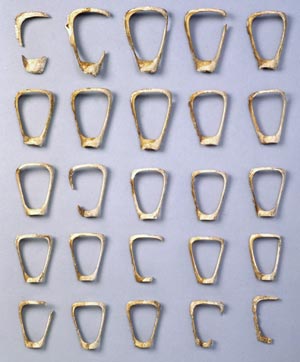Yoshinogari:
An Early Han Dynasty bronze mirror is recovered from the seal of a burial jar's lid. The grave of a woman dressed in silk, with shell bracelets stacked tightly on both arms, is discovered.

Methods of fashioning horizontal type (left) and vertical type (right) bracelets from cone shells |

Bronze mirror |
Yoshinogari Site, Kanzaki Town/Mitagawa Town/Higashi Seburi Village, Saga Prefecture
Designated as a special historic site, Yoshinogari is located atop a ridge in the southern foothills of the Seburi mountains, and consists of the remains of a large-scale settlement and burial grounds from the Yayoi period. Beginning at the start of the Early Yayoi period as a small moated village, it developed from 2.5 hectares in the Early Yayoi to over 20 hectares in the Middle Yayoi, and then into the colossal size of 40 hectares in the Late Yayoi period. As for the burial grounds, in addition to a cemetery of jar burials made in extremely long rows, a large burial mound yielding bronze daggers and large numbers of cylindrical glass beads, in which succeeding members of the chiefly line are thought to have been interred, is worth special mention.
Discovery of a bronze mirror and shell bracelets
A bronze mirror and shell bracelets were recovered from a stone-lidded jar burial of the latter half of the Middle Yayoi period, in the southern portion of the cemetery containing the long rows of burials. The bronze mirror was recovered fractured from within the clay used to seal the space between the mouth of the jar and the stone lid, although it is thought to have been originally put in place in one piece. It is 7.4 cm in diameter, bears an eight-character inscription, and is a finely made example of the renkomon style (having a pattern of interconnected arcs) from the Early Han Dynasty.
The shell bracelets were made from cone shells (family Conidae) from the south seas, and were found placed on the arms of the skeleton of a woman buried in the jar, with twenty-five vertical type items on the right arm, and eleven horizontal type items on the left. The bracelets of both arms were placed with slightly larger items at the base of the hand, smaller ones at the wrist, then becoming gradually larger toward the elbow. If worn with no gaps separating adjacent bracelets, the total lengths appear to be the same for both arms. The find is the largest number of bracelets made of shell from the south seas worn on a single arm, and fragments of silk cloth which appear to have been clothing were recovered in the vicinity of the bracelets.
The jar burial's occupant
Dressed in silk, wearing numerous bracelets of shell from the south seas that shone like pearls, and possessing a finely made Chinese bronze mirror, the occupant of this jar burial, thought to be a priestess, gives direct testimony to international relations during the Yayoi period, and provides important data for understanding Yayoi society and social status or class. Further, it is thought that the bronze mirror, placed atop the jar's rim with its reflective surface facing outward, was held to have efficacy in defending against malevolent spirits trying to penetrate the grave from the outside. (Shichida Tadaaki)




